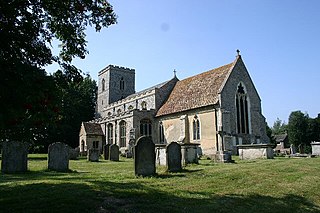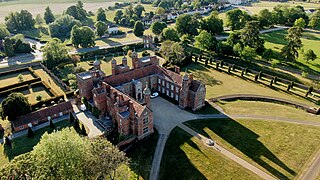
Oxfordshire is a landlocked county in the far west of the government statistical region of South East England. The ceremonial county borders Warwickshire to the north-west, Northamptonshire to the north-east, Buckinghamshire to the east, Berkshire to the south, Wiltshire to the south-west and Gloucestershire to the west.

Sudbury Hall is a country house in Sudbury, Derbyshire, England. One of the country's finest Restoration mansions, it has Grade I listed building status.

Horton is a hamlet in the parish of Ivinghoe, in Buckinghamshire, England. It is in the civil parish of Slapton.

Ridley Hall is a theological college located on the corner of Sidgwick Avenue and Ridley Hall Road in Cambridge, which trains men and women intending to take Holy Orders as deacon or priest of the Church of England, and members of the laity working with children and young people as lay pioneers and within a pastoral capacity such as lay chaplaincy.

The Senate House is a 1720s building of the University of Cambridge in England, used formerly for meetings of its senate and now mainly for graduation ceremonies.

Gazeley is a village and civil parish in the West Suffolk district of Suffolk in eastern England and is part of the West Suffolk UK Parliament constituency. In 2005 it had a population of 740. A house converted from a windmill survives in the village. The surnames of Gazeley, Gazley and Gazlay derive from this source.

Coade stone or Lithodipyra or Lithodipra was stoneware that was often described as an artificial stone in the late 18th and early 19th centuries. It was used for moulding neoclassical statues, architectural decorations and garden ornaments of the highest quality that remain virtually weatherproof today.

The Kimpton Clocktower Hotel is a historic hotel structure at the corner of Oxford Street and Whitworth Street in Manchester, England. The building was originally constructed in segments from 1891 to 1932 as the Refuge Assurance Building.
Elkington is a civil parish in the East Lindsey district of Lincolnshire, England. It comprises the village of South Elkington, and the hamlets of North Elkington, Boswell, and Thorpe, and is situated approximately 3 miles (5 km) north-west from the market town of Louth.

Abbas Hall is a small country house in Great Cornard, a village located near the town of Sudbury, Suffolk in England, the Elizabethan exterior of which masks a medieval two-bay aisled hall of c.1290, from which two massive oak posts with moulded capitals and two arches of the screens passage survive. The inserted floor in the great hall was put in about 1548–49. The house was originally the house of West Malling Abbey's manorial steward here. The house, from the grounds of which Thomas Gainsborough painted his celebrated view of Great Cornard Wood, was restored by the present owner, Stefan Kosciuszko, Chief of Staff Hinduja Group, and chief executive AMAS-IPS, the project development company for the Group, after 1995.

Ashwell Bury, at Ashwell in Hertfordshire, England, is an early 19th-century house of white brick, perhaps originally built before 1836 for Edward George Fordham (1782–1868); altered c. 1860 for Edward King Fordham (1810–99), who extended the family landholding; and then further remodelled in 1922-1926, chiefly inside, by Sir Edwin Lutyens for Phyllis Fordham, who had grown up at Henlow Grange.
Auburn Bay is a suburban residential neighbourhood in the southeast quadrant of Calgary, Alberta. It is located at the southeastern edge of the city, and is bounded by Seton Boulevard to the south, Deerfoot Trail to the west, 52 Street E to the east and Stoney Trail to the north.

Tame Valley Junction, also known as Doe Bank Junction, is a canal junction at the western limit of the Tame Valley Canal where it meets the Walsall Canal, south of Walsall, in the West Midlands, England.

Melford Hall is a stately home in the village of Long Melford, Suffolk, England. Since 1786 it has been the seat of the Parker Baronets and is still lived in by the Hyde Parker family. Since 1960 it has been owned by the National Trust.

Somerford Hall is an 18th-century Palladian style mansion house at Brewood, Staffordshire, which now serves as a wedding venue. It is a Grade II* listed building.

38 and 42 Mosley Street in Manchester, England, is a double-block Victorian bank constructed between 1862 and c. 1880 for the Manchester and Salford Bank. It was occupied in 2001 by the Royal Bank of Scotland. The original block of 1862 was the "last great work" of Edward Walters, and the extension of the 1880s was by his successors Barker and Ellis. It is a Grade II* listed building.

Denham Castle, also known as Castle Holes, is a medieval motte and bailey castle near the village of Gazeley, Suffolk, England. The castle was also known as Desning Castle at the time of building and occupation.

Moreton Hall is a Grade II* listed building in Bury St Edmunds, a market town in the county of Suffolk, England. It was designed by the Scottish architect Robert Adam and built in 1773 as a country house for John Symonds (1729–1807), a clergyman and Professor of Modern History at Cambridge University. The building was originally known as "St. Edmund's Hill". It was later called "The Mount" and from 1890 "Moreton Hall".

Stowe House in the parish of Kilkhampton in Cornwall, England, UK, was a mansion built in 1679 by John Grenville, 1st Earl of Bath (1628–1701) and demolished in 1739. The Grenville family were for many centuries lords of the manor of Kilkhampton, which they held from the feudal barony of Gloucester, as they did their other principal seat of nearby Bideford in Devon. It is possible that the family's original residence at Kilkhampton was Kilkhampton Castle, of which only the groundworks survive, unusual in that it had a motte with two baileys.

Moseley Hall is a Grade II listed 18th-century country house which was situated in parkland in Moseley, Birmingham. The hall itself is now part of Moseley Hall Hospital and much of the surrounding estate has been developed for roads and housing.


















